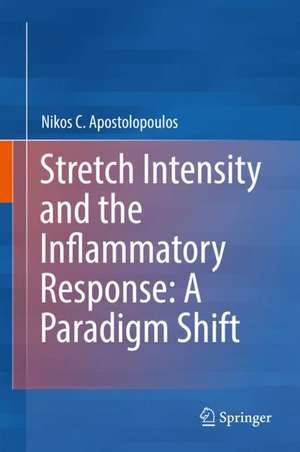Stretch Intensity and the Inflammatory Response: A Paradigm Shift
Autor Nikos C. Apostolopoulosen Limba Engleză Hardback – 10 ian 2019
Preț: 948.47 lei
Preț vechi: 1156.67 lei
-18% Nou
Puncte Express: 1423
Preț estimativ în valută:
181.51€ • 187.51$ • 151.06£
181.51€ • 187.51$ • 151.06£
Carte tipărită la comandă
Livrare economică 26 martie-09 aprilie
Preluare comenzi: 021 569.72.76
Specificații
ISBN-13: 9783319967998
ISBN-10: 3319967991
Pagini: 168
Ilustrații: XVIII, 231 p. 92 illus., 83 illus. in color.
Dimensiuni: 155 x 235 mm
Greutate: 0.53 kg
Ediția:1st ed. 2018
Editura: Springer International Publishing
Colecția Springer
Locul publicării:Cham, Switzerland
ISBN-10: 3319967991
Pagini: 168
Ilustrații: XVIII, 231 p. 92 illus., 83 illus. in color.
Dimensiuni: 155 x 235 mm
Greutate: 0.53 kg
Ediția:1st ed. 2018
Editura: Springer International Publishing
Colecția Springer
Locul publicării:Cham, Switzerland
Cuprins
1. INTRODUCTION.- 2. LITERATURE REVIEW.- 3. STUDY ONE – Acute Inflammatory Response to Stretching.- 4. STUDY TWO – Stretch Intensity vs. Inflammation: Is There a Dose-Dependent Association?.- 5. STUDY THREE – The Effects of Different Passive Static Stretching Intensities on Perceived Muscle Soreness and Muscle Function Recovery Following Unaccustomed Eccentric Exercise – A Randomised Trial.- 6. SUMMARY DISCUSSION.- 7. LIMITATIONS.- 8. FUTURE RESEARCH.- 9. CONCLUSIONS.
Notă biografică
Nikos C. Apostolopoulos PhD, a recovery and regeneration specialist, is the founder of microstretching® and stretch therapy®. He received his PhD and MPhil from Wolverhampton University (UK) and his BPHE (sports medicine) from the University of Toronto (CAN). Nikos has worked and continues to work and consult with professional, elite, and amateur athletes, and with numerous sports organisations (NHL, NBA, NFL, EPL, MLS, NCAA, ERL). Presently, he is affiliated with the Faculty of Kinesiology and Physical Education, University of Toronto (CAN), is an editor for numerous international sports journals, and is a member of IASP and ISEI.
Textul de pe ultima copertă
In this manuscript, practitioners and students who are concerned with sports and rehabilitation medicine, kinesiology, as well as coaches and athletes, are introduced to numerous concepts, including mechanotransduction, inflammation, pro- and anti-inflammatory cytokines, calpains, the extracellular matrix, neutrophils and macrophages, and their relevance to stretching, particularly stretching intensity. Although the quantitative parameters of training, duration, and frequency are important, it is the qualitative criterion of intensity (“how much”) that the author suggests is ultimately of greater concern. Intensity, the rate and magnitude of force, may be responsible for the proper recovery, regeneration, and adaptation of the musculoskeletal tissues from training, competition, or rehabilitation from injuries. Research suggests that too much force results in the stimulation of an inflammatory response, one associated with a biochemical feedback emerging from a mechanical stimulus. The intent of this manuscript is twofold: to initiate the discussion of the importance of stretching intensity with regard to proper recovery, regeneration, and adaptation, and to suggest that researchers need to explore its potential role in addressing numerous inflammatory (RA) and non-inflammatory (OA, recurrent tendinitis etc.) musculoskeletal conditions as well.
Caracteristici
Introduces the theory that the magnitude associated with stretching intensity is a mechanotransduction response, concerned with the relationship of the cells and tissues to their environment, translating any physical input or mechanical perturbation into a biochemical signal Takes a unique approach -- attempts to quantify the magnitude of stretching intensity by referring to the inflammatory response, down to a cellular level investigates the importance of stretching intensity to aid the recovery of athletes from training, competition, and injury, as well as the rehabilitation of individuals suffering from various musculoskeletal disorders
